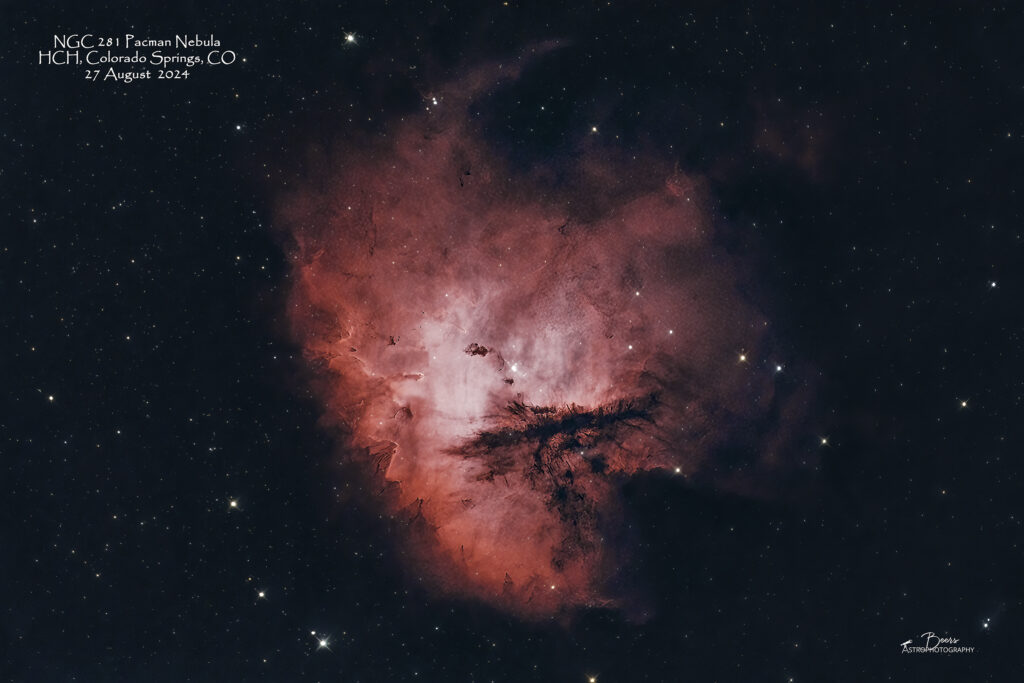
Target Fun Facts
NGC 281 Pacman Nebula: NGC281, IC11 or Sh2-184 is a bright emission nebula, part of an HII region in the northern constellation of Cassiopeia, and a part of the Milky Way’s Perseus Spiral Arm. This 20×30 arcmin sized nebulosity is also associated with open cluster IC1590, several Bok globules and the multiple star, B1. It collectively forms Sh2-184, spanning over a larger area of 40 arcmin. A recent distance from radio parallaxes of water masers at 22 GHz estimated it lies 2.82±0.20 kpc. (9200 ly.) from us. Colloquially, NGC 281 is also known as the Pacman Nebula for its resemblance to the video game character.
Edward Emerson Barnard discovered the nebula in August 1883, describing it as “a large faint nebula, very diffuse”. Multiple star ‘B1’ or β1 was later discovered by S. W. Burnham, whose bright component is identified as the highly luminous O6 spectral class star, HD 5005 or HIP 4121. It consists of an 8th-magnitude primary with four companions at distances between 1.4 and 15.7 arcsec. There has been no appreciable change in this quintuple system since the first measures were made in 1875.
Other Catalog Designations: IC 11, Sh2-184, Sharpless 184, LBN 616, LBN 123.17-06.28
Subtype: Emission Nebula
Distance from Earth: 9500 light years (2900 pc)
Apparent Size: 35’
Constellation: Cassiopeia
{Target information derived from: https://en.wikipedia.org/wiki/NGC_281 and Stellarium}
Equipment: All equipment controlled by HP Probook running Sequence Generator Pro v4.4.0.1339.
- Imaging (ASI2400-BB-LeX): ZWO ASI2400MC imaging camera on (Big Bertha) Orion 8″ f/8 Ritchey-Chretien Astrograph Telescope, TS 2.5” Rack and Pinion Focuser, Teleskop Service Flattener 1.0x for RC Telescopes (TS-RCFLAT2), Optolong L-Extreme LP filter (LeX)
- Autofocuser: ZWO EAF Electronic Automatic Focuser (EAF-5V-STD)
- Mount: Rainbow Astro RST-300 (controlled by iHubo ASCOM driver)
- Polar alignment: QHYCCD camera (controlled by Polemaster for polar alignment)
- Autoguiding: Orion 60mm Multi-Use Guide Scope with Orion StarShoot AutoGuider Pro Mono Astrophotography Camera (controlled by PHD2)
Capture & processing notes: This was the first of three clear nights, around the late August/early September New Moon that gave me a chance to run SGP’s step-size exercise with the EAF. I had completed the experiment to determine in/out movement with the TS 2.5” R&P focuser, right after it arrived. That experiment determines if the focuser is moving the same distance in and out against gravity given the same movement command. The focuser in/out movement exercise can be done inside, during the day. But I hadn’t had a clear night since the 16 August 2024 R&P focuser’s “first light” (where I ended up turning off the EAF because I spent three hours trying to get it to work – and never did!) to do the SGP step-size exercise – which requires outside, clear, night time, with real stars to test the SGP EAF’s autofocus algorithm to determine its correct step-size.
I decided to start with Big Bertha and the LeX filter imaging the NGC281 Pacman Nebula, which I hadn’t imaged since my early AP days in September 2021. Even though the Sept2021 image was captured in the dark skies of Mills Canyon Rim, it was not a noteworthy result!
I got started at about 2030MDT, once astronomical twilight was in full swing, getting the telescope polar aligned, the cabling and power all connected. I first ran the EAF on the focus star sequence (Sadr) with a step size of 150 – and it performed very well. I could have just gone with that lucky guess, but decided to run the step-size exercise to get the real, correct answer. The result was 150 steps per move, with 9 moves. So, I set that into the BB equipment profile and began the sequence.
I started the sequence by 21:15 – just about an hour from set-up through gaining successful EAF step-size knowledge, to capture! The focusing run that ran at the beginning of the sequence, run in the target region, the EAF’s focus algorithm worked well resolving the focus point – giving me the confidence to run the sequence throughout the night with the EAF refocusing every 60 minutes – for the first time since I’d purchased the EAF late last fall. So, technically, this was “First Light” with the ZWO EAF!
Sequence Plan (27Aug2024): Gain: 158, Temp: -0°C, offset=30. 67x5min. Captured 27Aug2024, 21:23MDT – 28Aug2024, 03:35MDT. Total exposure time: 335min, 5:35hrs (ASI2400-BB-LeX)
Processing: Captured in SGP, stacked in APP (HaOIII Color), star removal with Starnet++, processed with LR/PS
